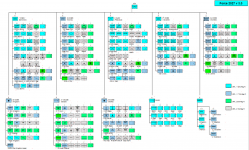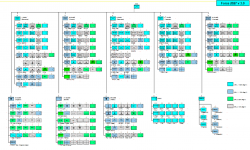I've been threatening to do this for some time now so here goes with my revised Canadian Army for 2027 ('cause 2025 is almost here)
Here are the ground rules:
1. No new PYs and using existing ResF authorized strength; and
2. No new major equipment but place markers for future capabilities indicated; and
3. An assumption that organizational/legislative changes are made to enable an effective ResF element.
Major objectives:
1. Increase the number of brigade headquarters and manoeuvre battalion headquarters that are capable of deploying on peacetime rotations;
2. Increase the number of trained company level organizations that can deploy on rotations;
3. Decrease the number of PYs allocated to RegF capabilities that do not deploy frequently during peacetime;
4. Eliminating unnecessary and non deployable headquarters; and
5. Assigning RegF command authority and responsibility for ResF training and organization.

Notes:
1. All divisional headquarters and six of ten ResF headquarters have been elliminated and their RegF personnel reallocated. While 1 Cdn Div is not an Army resource, it should in name be elliminated and its staff integrated into CJOC to manage deployments. The only potential role for any divisional command elements for Canada are with one of the NATO Multinational corps. Accordingly a company size divisional HQ staff assigned to the MND-N has been included with 33 CSB in Kingston.
2. All RegF units have been broken up leaving appx 70% of the manpower with their original units/formations while the remaining 30% together with PYs from div HQs, Disbanded ResF brigades and all RSS positions have been reallocated across the entire force. so that all manoeuvre battalions have a minimum RegF strength of 30% to 70%. In total, deployabel brigade headquarters have increased for three to five and deployable manoeuvre battalion headquarters from 12 to 22. Each manoeuvre battalion (including cavalry) has at least one full-time RegF company which provides sufficient strength to train the unit's personnel. There are 31 full-time RegF deployable manoeuvre companies augmented by 37 Res F Manoeuvre companies.
3 RegF artillery and Engineer regiments generally do not deploy in peacetime and therefore have had their PYs redistributed but within their branch to support ResF regiments.
4. Company/squadron/battery structures have been reduced as follows: CS companies have been elliminated from combined arms ans LAV battalions (bn mortars and recce now fall under bn HQ); FOO batteries and STA batteries have been removed from CS artillery regiments (Fsccs/FOOs return to gun batteries, STA becomes a troop within RegtHQ. A GS medium UCAV anti-armour battery has been added to each CS regiment; Bde Engineer Regiments are reduced to two field sqns but have the brigade Sigs Sqn and a new MI compnay under command for administration. Sp/Adm coys are removed from the Bde Svc Bns - all support for the battalion comes from the remaining maintenace and supply and tpt coys. The Bde Fd Amb is attached to the Svc Bn for admin.
5. A cavalry regiment has been added to each manoeuvre brigade consisting of a recce sqn (with recce UAVs), an infantry company (with ATGMs) and a ground and light UCAV anti-armour squadron)
6. Every 100% RegF unit is fully equiped from current weapon allocations except (HIMARS and AD batteries are notional at this point)
7. All dividional support establishments are reassigned to the Cdn Army Support Group which is a non deployable, base support entity
8 Individual trg remains the primary responsibility of CADTC with much of it delivered through Depot Bns and companies located close to RegF and ResF units. Recruiting for Army personnel and all BMQ/BMOQ training shall also fall to the Depot Bns.
9. The current CSSB and two of the Res F brigades shall be restructured as two CCSBs and a Sustainment Brigade. to provide above brigade level deployable resources.
10. ResF battalions and regiments shall be reorganized as company sized entities which shall be assigned to one or another battalion within one of the various brigades. Each Bn/Regt HQ shall be responsible for sharing its existing equipment and collective training of their various RegF and ResF members albeit such training will be done at times most appropriate to the members concerned (eg. ResF training shall be primarily during summer months and on one weekend per month)





